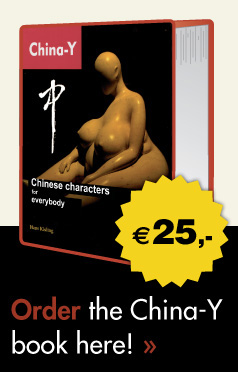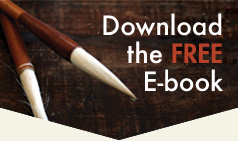Research
A character, purely based on the image of the intended, is called a pictogram.
English: you could indicate a cat with the image of a whiskered, hairy animal head.

Chinese: a horse was denoted with the image of a trunk, a head, a mane, four legs and a tail.
![]()
Research
Spoken: mā
Various pictograms are composed of different elements that can be found again in other combinations.
English: this pictogram satisfies the formula:

bike + roof = bike shed
Chinese: this pictogram satisfies the formula: child + woman + mother’s breast = mother’s milk, milk
![]()
The single pictograms as well as the complex ones can represent concrete, figurative and also abstract notions.
‘Horse’ and ‘bike shed’ signify clearly a being and a building. In the wanderers language of North America this image of a ‘cat ‘ means: a nice lady lives here.
In the picture of ‘mother with breast and child’ two images indicate a concrete meaning, ie. milk. As it appears from this book, the possible combinations of abstract and concrete elements are almost endless. Obviously still insufficient to draw or mean everything.
As a result, in the course of time, the so called phonogram originated, which is one pictogram joined to another, where only the sound family is important and not the meaning.
English: bottle + phon (ogram) cat = catering
The ‘cat’ has lost her meaning. Only the comparative sound of the image is used in combination with the pictogram ‘bottle’ which indicates drink and everything associated with it.

Chinese: woman + phon (ogram) horse = mother
MAMA Spoken: mā
Here the horse has also lost its original meaning and only the utterance ‘mā’ is applicable.

Some historical language experts still want to explain the last character composition as ‘a mother is a woman with the strength of a horse’. This is nice as an aid to memory but historically untenable. That is why in this work this approach is passed over as far as possible in order not to unnecessarily tax the Chinese student with quasi-knowledge which he will have to put aside again at a later stage.
Although admittedly in our ‘Swiss cheese knowledge’ of etymology fact and fiction often inter-mingle.
In summary we arrive at the following subdivision of a character:
Pictogram
Or pictogram + pictogram
Or pictogram + pictogram + pictogram
Or pictogram + pictogram + pictogram + pictogram
Or pictogram + pictogram + pictogram + pictogram + pictogram
Or pictogram + pictogram + pictogram + pictogram + pictogram + pictogram
Plus possibly:
Phonogram, consequently indicated in the text by ‘fon’ or ‘(fon)’ when a logical explanation is also useful.
With every single or composite character that can be indicated as a pictogram there is an accompanying illustration. In dubious cases, eg (fon), sometimes an illustration is chosen and sometimes not. For a (as yet very limited) list of fon characters see the final pages of the book.


 sending...
sending...